Chongqing Urban Renewal | Eighteen Ladders, Reshaping Mountains, Rivers, Years, and Human Fireworks
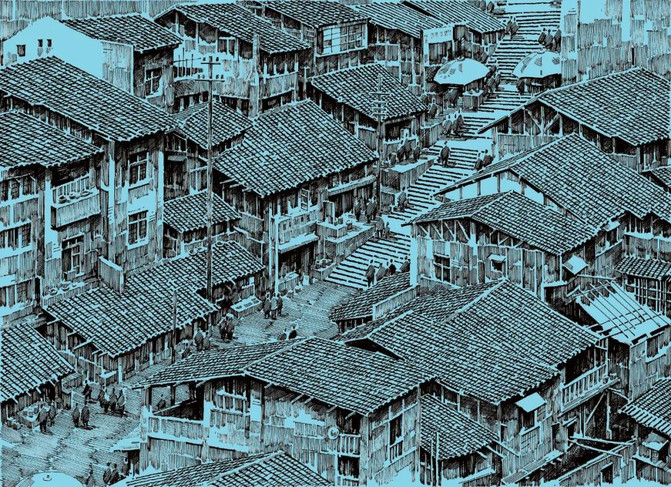
Hand drawn street view of Shiba Ti Pedestrian Street/photo provided by Ouyang Hua and the Cultural and Tourism Commission of Yuzhong District
Eighteen steps is not just a place name. It used to be a life path and passage of time that mountain city people must pass through, and it is the deepest homesickness of Chongqing people. For hundreds of years, it has undergone several changes, with its prosperity declining for a few autumns.
Here, celebrities and nobles, diplomatic envoys, peddlers and soldiers, daily fireworks slowly extend, and countless people temporarily stay here.

18 Stairs and 18 Stairs Company provided pictures before the renovation
Eighteen staircases, witnessing the century old warmth and loneliness of Chongqing's mother city, enduring wars but becoming stronger.
This encompasses all the good and bad, joys and sorrows, separations and reunions of the human world.
Countless people from Chongqing and other places have wandered around here, walking down the stairs or straight up, then searching for small alleys and turning back, walking casually, touching the most primitive Chongqing, the oldest mother city, and doing nothing else.

18 Stairs and 18 Stairs Company provided pictures before the renovation
The most unchanging thing in the world is farewell. People yearn for the warmth and warmth of their neighbors, the noisy yet genuine lives, but the poor living environment and safety hazards have almost taken away the enthusiasm and willingness of many people to continue staying. More than a decade ago, people finally felt it was time to say goodbye to the declining Eighteen Stairs.
Unable to let go, the eighteen steps once again started the wheel of history. Penetrating history, painting with sadness. They used affirmative votes to press the forward button for the eighteen staircases, which had been stagnant for decades.
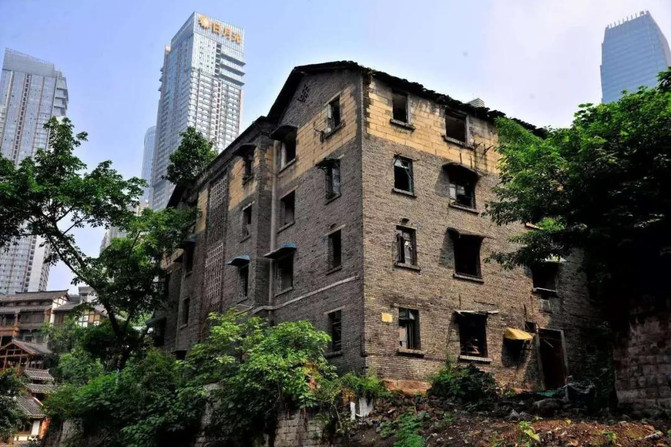
The pictures of the eighteen staircases before the renovation are sourced from the internet
Will the Eighteen Stairs Revive Prosperity? At present, the answer seems to be affirmative.
The relevant departments at both the urban and rural levels have actively planned and revised their drafts; With a reverence for history and culture, Xintiandi Group has been working in this small area for more than four years. It is mindful of the past, inherits the classics and makes meticulous progress.
In September 2021, the Eighteen Stairs Traditional Style Area will officially reunite with people. Before the arrival of this day, let us step into the past years and stories of the Eighteen Stairs.
Everything feels like yesterday.
Everything feels like a world apart.

The vicissitudes of the 18 staircases cannot be fully explained by the bluestone board road. The company provides pictures of the 18 staircases
Humans live by the water, so at the confluence of the two rivers, there is the mountain city of Chongqing. The same goes for the Eighteen Stairs.
It is said that there used to be an old well in the area, which was exactly eighteen steps away from the residents' residences, so it gradually became known as the "Eighteen Stairs".
This statement is not a wild history. Many years ago, a reporter from Chongqing Times interviewed a centenarian living in the old block of Houci Street. According to her recollection, she once heard from her elders that there was indeed an old well located near the original No. 160 Eighteen Stairs, where people drew water for drinking, carried water for laundry, and were extremely lively.
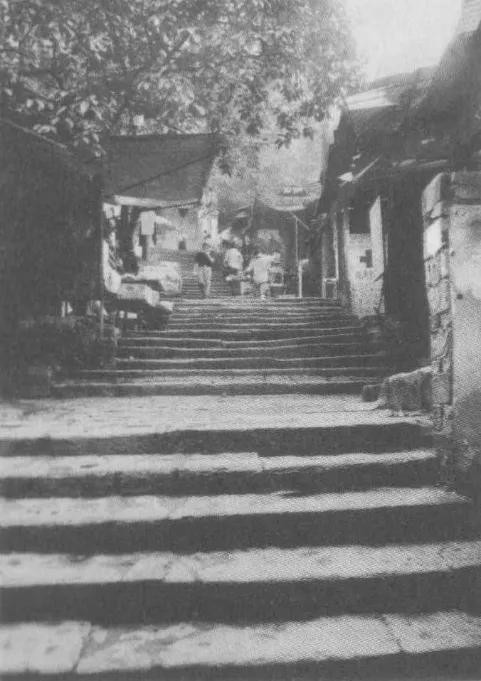
The old Eighteen Ladder Company provided pictures
The well was indeed eighteen steps away from the surrounding residential area, but later it dried up and was abandoned. Later on, the road was repaired and this well was filled. Li Zhengquan, a well-known cultural and historical scholar in Chongqing, believed that when Monument to the people's Liberation was not a commercial area, it was still a forest, and naturally groundwater seeped down the eighteen stairs to form well water. When the upper part was opened up as a residential area, the well water dried up, which was also in its logic.
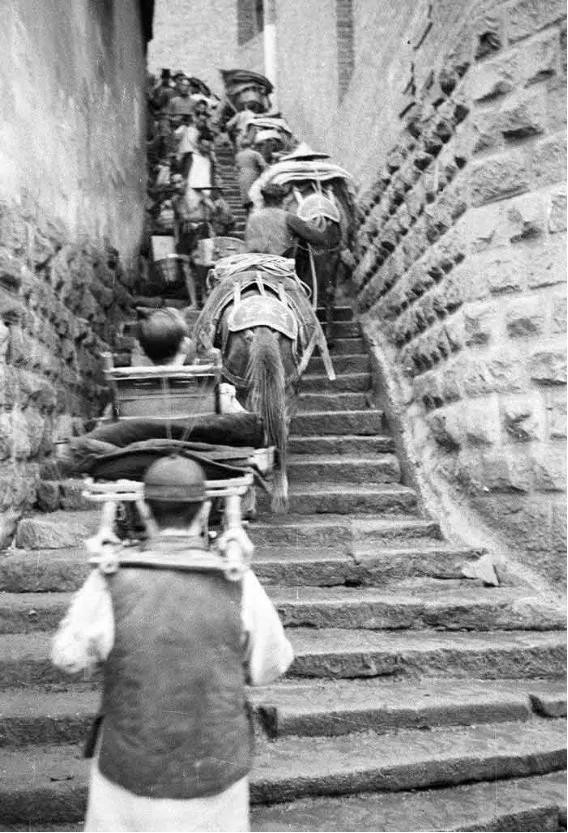
The old Eighteen Ladder Company provided pictures
Named after a well is currently the most widely recognized statement. However, during our research process, we also discovered another type of sound. We present it for everyone to understand and discuss.
Another theory suggests that during the Ming and Qing dynasties, people built stone staircases and small paths here for convenience. Due to the steep slopes at both ends, the stairs were divided into eighteen sections, each with a platform for pedestrians to rest, hence the name "Eighteen Ladders".
One source of water, one source of mountain, these are the eighteen staircases of Chongqing, the city of mountains and waters.
The reason why the Eighteen Stairs hold such an important position in the hearts of old Chongqing people can be traced back to the upper and lower half of the city.
Divided by nine open and eight closed city gates and walls, the mother city of Chongqing was dotted at the head of the Yuzhong Peninsula during the Ming and Qing dynasties. Its area was not large, but due to the presence of the Huaying Mountains, the city was divided into upper and lower halves with a drop of several tens of meters. The lower half of the city is around Nanjimen and Jinzimen, and the upper half is around the present Jiaochangkou and Monument to the people's Liberation.

Map of the Eighteen Stairs and Surrounding Areas in the Late Qing Dynasty
During the Ming and Qing dynasties, Chongqing was the gateway to Sichuan, with convenient land and waterway transportation. Many merchants and traders also stopped here for transit, so the area from the lower half of the city to Chaotianmen was a bustling place at that time. At this time, the area from the Eighteen Stairs to the Upper Half of the City was relatively remote, and the military training ground was set up nearby. The current gate of Fudan Middle School was the location of the entrance to the training ground and military camp at that time.
With the prosperity of commerce and the rapid increase in population, people have also begun to settle down and work in the upper half of the city. At this point, the important position of the Eighteen Stairs as a connecting passage between the upper and lower halves of the city is evident. You should know that Zhongxing Road and Kaixuan Road, which connect the upper and lower parts of the city today, were only built during the Anti Japanese War. The importance of the eighteen staircases at that time can be imagined.

Map of Eighteen Stairs and Surrounding Areas in the 1940s
Although the Eighteen Stairs are sloping, it is not impossible to build houses along the mountain. The flow of people surged, and commercial economy and cultural life gradually became hot. After several developments, the Eighteen Stairs were no longer just a passage. Wealthy merchants, nobles, and ordinary people came here to buy land and build houses. At that time, this place became a bustling place.
Yongxing Lane, located within the Eighteen Ladders, was named after the well-known Yongxing Pawnshop at that time, while Jiaopu Lane was named after the fact that the alley was filled with wealthy people sitting in sliding sedan chairs; As for Huajiezi, this famous ancient land of wind and moon was a symbol of the prosperity of commerce at that time. Later on, on the former site of the French Consulate at 35 Phoenix Terrace, historical events unfolded.

The portrait pictures of the former site of the Eighteen Stairs are sourced from the internet
According to historical records, it is inevitable to suffer injuries during marching and fighting, so there are numerous traditional Chinese medicine clinics in the area of Shiba Ti. At the same time, due to the convenience of the dock, it has also become a gathering place for medicinal herbs, and medicinal merchants come and go frequently.
The memorial archway of the Ming and Qing pavilions are stacked up along the street according to the terrain, and are well arranged. The ladies in the attic are leaning on the "beauty", quietly watching the bustle and prosperity of the street; This seems to be a three-dimensional version of the Qingming Riverside Scene, where sedan chair bearers, boatmen, laborers, soldiers, merchants, travelers, revolutionaries, foreigners... all gather here.

The ruins of the "Daguanping Stone Carvings" on the Huangtu Slope of the Eighteen Ladder Plain, provided by the Eighteen Ladder Company
Here, the most Chongqing's human fireworks and past time are preserved.
The winding and steep stone steps connect the bustling commercial district of the mountain city with the old city area by the river below, witnessing the real life of the old Chongqing people.
This is the Chongqing version of 'Along the River During Qingming Festival'.
The Eighteen Ladders showcase the mountainous urban form and spatial characteristics of "Born Chongqing", the road structure of "horizontal streets and vertical alleys", and the street and alley space of "uphill and downhill, winding and twisting", which together constitute the traditional mountain city living space, carrying the changes in urban life and the evolution of temporal and spatial patterns. It is a spatiotemporal product of the joint effects of regional politics, economy, culture, and so on.
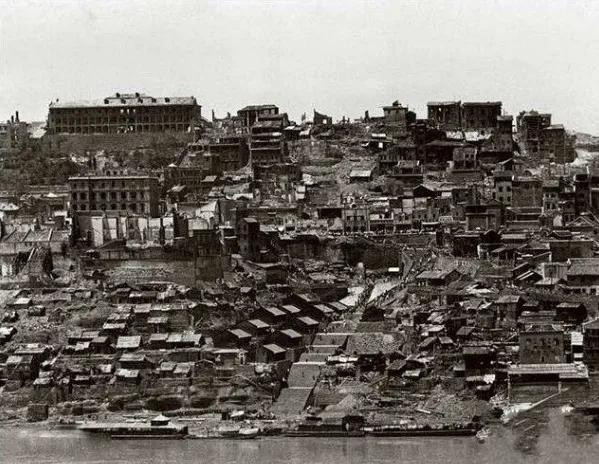
The old Eighteen Ladder Company provided pictures
No. 171, Eighteen Stairs, is a building from the Republic of China era. It was originally a salt merchant association. In order to do business, salt merchants went to Hechuan and salt traders went to Wushan and other places to purchase. They are all planning, bargaining, or sharing profits in the salt merchant association. They have salt, and then they contact cargo ships or find today's "Bang Bang" to negotiate resources with them, and then transport the salt cargo onto the ship. After everything is done, the salt is transported to various places through the Jialing River and Yangtze River.
Salt merchants and salt vendors want to sell salt at a high price, and the Salt Merchant Association plays a significant role. Various salt merchants came to the guild hall to drink tea, chat, and discuss business. People came and went, and business flourished.

The former site of Salt Merchant Association, No. 171, Shiba Ti
At the entrance of the 18 step air raid shelter is Shanguo Lane. According to historical records, in the late Qing Dynasty, residents of Shanguo Lane spontaneously pooled their money to buy oil and light lamps for the convenience of night time pedestrians, and did good deeds and rituals, earning their name for the fruits they brought. Originally, there was a Guanyin Temple here, and the true "Guanyin Rock" of Chongqing is located here.
Continuing downwards, after the middle section of the Eighteen Stairs, there is Houci Street, which is built next to the mountain, with the Yangtze River at the foot of the mountain.
It is said that Houci Street was once the "number one street in Chongqing", consisting of Haochi Street, Jinmasi Street, Shuangqizi Street, and Taiqian Street. It connects Zhongxing Road, Shiba Ladder, Huajiezi, etc.

The old 18 ladder hanging house, 18 ladder company photo provided
Some people say that Houci Street is the transportation hub and bustling area of the lower half of the city.
The old Houci Street was like a maze, with twists and turns, all of which were uneven hanging buildings. Every night, snack stalls spread throughout the streets and alleys, with tung oil lamps and kerosene lamps lighting up the shops.
Under each light, there is a food stall where vendors sell roasted meat, small noodles, fried peanuts, boiled soybeans, cold stir fried tofu, and more. Those dock laborers come to drink and eat after finishing a day's work. Among the diners, there are also those who disembark or stay at the hotel, also coming to have supper. In this way, there is the sound of punching and the noise rising one after another, often roaring until the next morning.

Eighteen ladder diagram before renovation/Zhang Song
Due to the homophonic sound of "delicious" in Chongqing dialect, Houci Street was called "Delicious Street". Over time, people found it indecent and renamed it "Haochi Street" after the large water pool used for fire prevention in the street, replacing "Delicious Street". After several changes, it merged with other alleys and was named "Houci Street".
Since the opening of Chongqing as a port in 1891, the city of Chongqing, as a commercial hub, has developed rapidly. The rapid increase in population has made it necessary to expand cities and change urban infrastructure. The first mayor of Chongqing, Pan Wenhua, took bold measures to demolish the city walls and build roads, leading to rapid development of urban transportation. Modern highways, represented by Nanqu Road and Beiqu Road, began to connect Chongqing city; After Zhongxing Road and Kaixuan Road are repaired, the Eighteen Ladders will no longer be the main passage connecting the upper and lower parts of the city.
But for the Eighteen Stairs, the real damage comes from the flames of war.

The pictures of Chongqing during the Anti Japanese War are sourced from the internet
After the outbreak of the War of Resistance Against Japan, Chongqing became the wartime capital, and the world's attention was focused on Chongqing. The Japanese artillery also aimed at Chongqing. From February 1938 to August 1943, Japanese aircraft carried out frequent air raids and crazy bombings on Chongqing, deploying over 9000 planes and dropping more than 11500 bombs.
In order to destroy Chongqing's morale and cause greater casualties, the Japanese often dropped incendiary bombs. This is undoubtedly a disaster for wooden and bamboo houses. According to survivors' recollection, after the bombing, there were often rubble and a sea of fire everywhere, which was unbearable to see.

The pictures of Chongqing during the Anti Japanese War are sourced from the internet
During this painful period, June 5th, 1941 will forever be remembered by history.
The 18 step air raid shelter at Jiaochangkou was the largest air raid shelter in Chongqing at that time. The air raid shelter is 10 meters deep and 2 kilometers long, with 3 exits and a height of 2 meters. Inside, there are wooden benches and an oil lamp at regular intervals for illumination. But the conditions here are rudimentary, with no water intake, ventilation, fire prevention, or gas defense facilities in the eighteen step air raid shelter.

The picture of the air raid shelter at Jiaochangkou is sourced from the internet
On the afternoon of June 5th, during more than five hours of "fatigue" bombing by Japanese planes, a tragic incident occurred in which evacuees suffocated and trampled on the air raid shelter tunnels in Shiba Ti, Yanwu Hall, and Lime City, resulting in approximately 2500 fatalities. The whole country and even the world were shocked by it.

We all know that since 1998, Chongqing has been sounding air raid sirens every June 5th to commemorate the victims of these air raid shelters and the people who left under the Chongqing bombing. Chasing the departed, warning the world.

The image of Chongqing after being bombed by the Japanese army is sourced from the internet
After the reform and opening up, the Chinese economy gradually took off. Chongqing is certainly among them.
Represented by Monument to the people's Liberation Pedestrian Street, Chongqing's economy and urban construction are developing at a high speed, while the once bustling Eighteen Stairs has gradually become silent.
Especially in the late 1990s, Nanjimen established a labor market, and a large number of migrant workers flooded into the city, also living in Shijiati. Most of the indigenous people gradually moved away, and the eighteen staircases began to appear old and messy.
At that time, the eighteen tiered market atmosphere was strong - consumption scenes such as cheap hotels, tea houses, ear picking shops, restaurants, cupping machines, mahjong parlors, etc., emerged with these residents. In this space that seems to have been forgotten by the times, it radiates a completely different pyrotechnic atmosphere from the modern city, especially when compared with the prosperous and fashionable Monument to the people's Liberation across the street, it shows a precious warm picture.

The pictures of the eighteen staircases before the renovation are sourced from the internet
For people living here, the Eighteen Stairs is their safe haven and the confidence they have in living in this city - the low cost of living here is undoubtedly full of warmth for them.
Since the end of the last century, more and more artists, photographers, and literary youths have turned their attention to the Eighteen Stairs. In an era where it is necessary to look back frequently, the Eighteen Ladders have also become a benchmark and representative in Chongqing. This eighteen ladder is loved by some people not because it is a land of hidden dangers, but because it gives those who barely live in the city a last chance and preserves the past time.
Those who pass by the Eighteen Stairs every day, except for those who shuttle between the upper and lower parts of the city, are mostly artistic "pilgrims" carrying backpacks and hanging DSLRs. Some netizens even commented, "Not going to the Eighteen Stairs is like never going to Chongqing.

The pictures of the eighteen staircases before the renovation are sourced from the internet
The green trees are shaded, the electrical wires are crisscrossed, and the aroma of vegetables and tobacco leaves in the pot mix together. The sound of street vendors selling goods echoed through the streets, and Hong Kong films were displayed in the video studio. Occasionally, a burst of laughter could be heard, and there were the eighteen staircases in my memory.
The winding and steep stone steps connect the bustling commercial district of the mountain city with the old city area by the river below, witnessing the real life of the old Chongqing people.
Undoubtedly, the reason why the Eighteen Stairs can attract so much attention is because it preserves a microcosm of old Chongqing life in the 1960s and 1970s. On both sides of the street, there is a strong sense of life, with small restaurants, hair salons, public video halls, clothing cutting shops, small tea houses, and more, showcasing the authentic old Chongqing lifestyle.
Many people feel familiar with the Eighteen Stairs at first sight, probably because all the old places have been imbued with a nostalgic scent of time.
Similarly, this is also the reason why some people leave it.

18 Stairs and 18 Stairs Company provided pictures before the renovation
Of course, this is the homeland of the locals, and the climate conditions can be compensated for by living conditions. But the house with eighteen staircases is too old: before the liberation, the house couldn't even talk about living conditions, and after the liberation, a long period of construction was focused on providing a place to live, without sufficient consideration for the quality of life. The per capita living area of most residents is very limited, and coupled with the inability to keep up with related interior decoration, the quality of living is very problematic.
Society is always progressing, and the stagnation of the Eighteen Stairs is not only due to environmental construction, but also due to the physiological and psychological needs of residents. Although there are many regrets, it is inevitable that it will be time to say goodbye.


18 Stairs and 18 Stairs Company provided pictures before the renovation
At this point, the decline of the Eighteen Stairs in recent years can be understood. People's hearts are constantly changing, and everyone has the right to pursue a comfortable life. Currently, the Eighteen Stairs will inevitably go through a period of neglect; The changes in urban construction have accelerated this process.
In 2008, Eighteen Stairs once again turned the wheel of history, and the pre renovation work of the dilapidated housing area was carried out in depth and detail.
At 4:30 pm on June 20, 2010, on the playground of Xinglin Middle School, with 96.1% of the votes in favor, people opened another chapter in the history of the Eighteen Ladders.

People's Daily reports on the voting process

Chongqing Morning Post reports on the voting process
How to repair the 18th ladder?
No decision is easy.
The person in charge of relevant departments in Yuzhong District once said, 'Change the manuscript by numbers.'. The Eighteen Ladders have attracted too much attention. To make the reborn Eighteen Ladders reflect the true essence of Chongqing, it must live up to the cultural context of this city.
For many years, Yuzhong District has commissioned multiple design units to develop implementation plans for the protection of the 18 elevators and traffic organization plans for the 18 elevators. It was not until 2016 that the implementation plan for the protection of the 18 elevators and the traffic organization plan passed expert review, officially concluded, and the overall control plan revision was basically completed.

The historical buildings preserved in the traditional style area of the Eighteen Stairs are provided with pictures by the Eighteen Stairs Company
On May 17, 2015, the fourth meeting of the Chongqing Planning Commission and the first meeting of the Chongqing Historical and Cultural City Protection Committee were held. The Shiba Ti Traditional Style Zone was designated as one of the 28 traditional style zones in Chongqing. The planned protection area extends east to Chongqing Daily, south to Jiefang West Road, west to Zhongxing Road, and north to Jiaochangkou, with a total area of 18.88 hectares, including 3.89 hectares of core protection zone, 7.17 hectares of construction control zone, and 7.82 hectares of style coordination zone.
Under the guidance of the "Protection and Utilization Plan for Traditional Scenery in the Main Urban Area of Chongqing" and the "Detailed Construction Plan for the Eighteen Ladder Traditional Scenery Area Project" approved by the Chongqing Municipal Government, the Yuzhong District Committee and Government vigorously promote protection, restoration, and revitalization utilization.
In May 2017, the Eighteen Stairs Traditional Style Area project officially started construction.

Eighteen elevators in construction, provided by the company for drawings
The Eighteen Ladder Area encompasses the joys, sorrows, separations, and authentic lives of Chongqing people, as well as the traditional mountainous block textures of "fishbone" and "cloud ladder" styles, and the architectural types and layout of "traditional Bayu". It includes one national key cultural relic protection unit, the former site of the French Consulate of the Allied Powers in Chongqing, and one municipal cultural relic protection unit, the site of the "June 5th" Tunnel Massacre in the Chongqing Bombing Site Group. There are also five unclassified immovable cultural relics scattered, including the Daguanping Stone Carvings and the Bird Crossing Cloud Stone Carvings. Additionally, there are three excellent historical buildings, 81 large trees, ancient trees, and "Seven Streets and Six Alleys" at No. 35 Shanguo Lane, No. 95 Houci Street, and the former site of the Match Raw Material Factory. Traditional streets and alleys, old staircases, old fortresses, old air raid shelters, and other natural and cultural landscapes with a strong Chongqing flavor... Here, too many historical stories and life atmospheres converge.
All of this is the wealth of time, but also a heavy responsibility.

Eighteen elevators in construction, provided by the company for drawings
To treat a piece of land and a building with care, in the opinion of Wang Rui, the deputy general manager of the Eighteen Stairs project, it depends on how we treat every blade of grass, every tree, and every brick and tile there. The traditional style area of Eighteen Stairs covers an area of 88 acres with a total construction area of 170000 square meters. According to the usual commercial project schedule, this volume can be completed in two years. However, the project company has been working on Eighteen Stairs for four years, carefully preserving its original flavor.
This is a planning and construction based on respecting the mountainous urban form of "Born Chongqing" with 18 staircases, and more importantly, based on protecting the endowment and temperament of "Old Chongqing" and "True Mountain City": continuing the original street pattern and texture of the traditional style area with 18 staircases; Persist in protecting and repairing dilapidated old buildings in their original location, height, scale, and materials; Through inheritance, implantation, and innovation of the "Ba Yu cultural style, architectural form, and new special formats"; Explore, refine, and create new formats, landscapes, and experiences such as "18 pieces, 18 flavors, and 18 landscapes".

Large scale demolition and construction are not difficult, but what is difficult is to both protect and build. Huangge tree, bluestone... these have all been preserved. The traditional style area of the Eighteen Stairs also continues the basic pattern of the "Seven Streets and Six Alleys" traditional streets and alleys. During the construction process, it is necessary to strictly protect the original natural ecological environment and the original terrain and landforms such as forts and steep slopes, which brings considerable difficulty to the construction.
For example, during the construction process, plastic boards were installed on the original bluestone road for protection. Building materials were not transported by vehicles, but were carried by traditional manual hands and shoulders. Although time-consuming and laborious, it effectively protected the century old stone ladder on site from damage.

Eighteen elevators in construction, provided by the company for drawings
The true essence of the mountainous city of Chongqing lies in its streets and alleys. In the view of literary and historical scholar Li Zhengquan, to understand Chongqing, the first step is to understand the streets and alleys, such as the one person alley, the alley within the alley, the cloud ladder alley, the house within the alley... Climbing on the ladder and walking through the alleys, you will gradually understand Chongqing.
Seven streets and six alleys.
This is the Xintiandi of the Eighteen Ladders.
It's also an old life.
People have long been looking forward to a reunion.
The fence around the urban balcony at the upper end of the 18 traditional style area that is about to open has been removed, and many citizens and tourists are standing there looking out from afar.
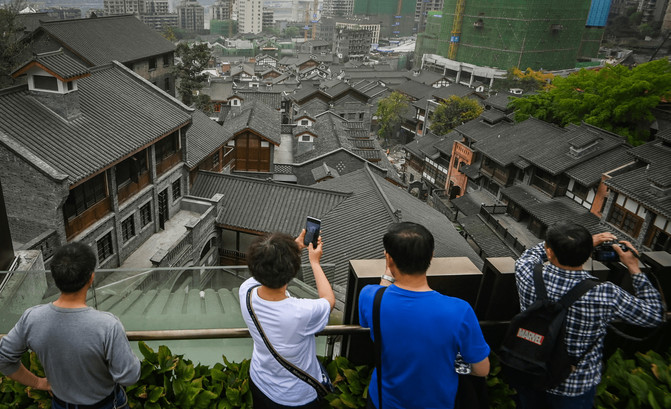
If you haven't been there for a long time, the scenery you see is very different.
Following the vicissitudes of the mountain terrain, the bluestone is built, with gray bricks and blue tiles laid out layer by layer, and hanging buildings scattered among them; Near the Phoenix Terrace in the distance, the former site of the Chinese Match Raw Material Factory stands tall with its hipped roof, parapet wall, small green tile pavement, brick columns and walls, showcasing the courage and resilience of the "Match King" Liu Hongsheng at that time. And next to it, there is a yellow ancient building echoing in the distance, which is the former site of the French Consulate.
We imagine that the prosperity of the Eighteen Stairs during the Ming and Qing dynasties may have looked like this.
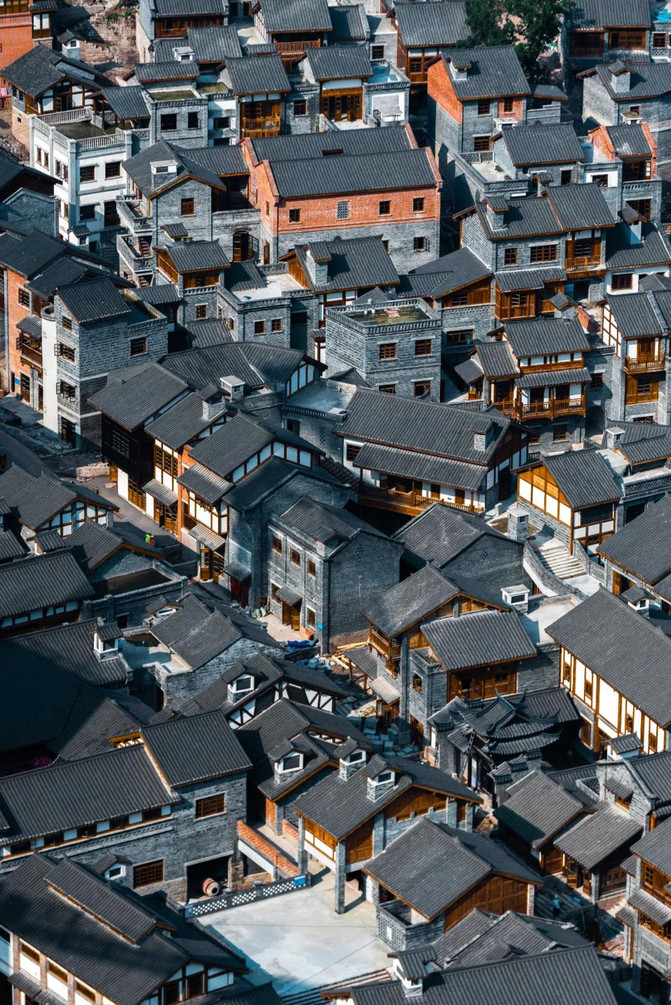
Overlooking the Eighteen Stairs by Chen Yunyuan
According to Wang Rui, the Eighteen Ladder Traditional Style Area will be divided into five zones based on the historical heritage of seven streets and six alleys, with "two experiences and two centers". Looking down from Jiaochangkou, on the right-hand side of Shiba Ti Main Street are A and B districts, which are also traditional cultural experience areas. Ba Yu traditional culture and common folk customs are presented here.
Especially the Mountain City Memory Museum located in Zone A, which is the result of careful polishing by the Eighteen Stairs team, gathers a large number of precious books, images, and video materials from old Chongqing, and uses digital technology to re present the memories, changes, and taste of life of the old mountain city in the public eye.


The left side of the main street is Area C, which is positioned as the China-Chic Cultural and Creative Experience Area. It will focus on the inheritance and innovation of traditional handicrafts, the exquisite research and development of project characteristic products, and the incubation of cultural and creative IP derivatives. Traditional cuisine from the Southwest will converge here, just like when the docks of Chongqing gathered visitors from all over the world.
The Phoenix Terrace and the former site of the French Consulate in Zone D, which serves as an international exchange center, represent the intersection of Chinese and Western cultures and business exchanges at that time, allowing the Eighteen Stairs to once again connect with the world. Huajiezi is located in Zone E, with the development direction of night economy and entertainment gathering, personalized leisure life, and immersive performance shows, creating a gathering place for trendy young people. The old place of wind and moon has been transformed into a new look, while the lively lights remain unchanged.

More details will fill the texture of the streets and alleys.
Shanguo Lane will utilize the space of the original stone steps and fortresses to showcase the street and city life; The drainage ditch, which was originally a famous flea market, will retain its creative and life market functions; The platform dam is named after the moon shaped dam in front of the Hu Ziang Mansion. Through the restoration of the courtyard and surrounding terraced environment, it reproduces the traditional scene of moon viewing; Jiaopu Lane, based on Jiaopu Lane, one of the "Three Great Jiaobang" in Chongqing, will develop experiential projects such as the "Sliding Rod" in the mountain city

Wang Rui believes that the traditional style area of the Eighteen Stairs will become a new cultural calling card for Chongqing in the future, with its cultural style, architectural form, and new special formats; eighteen pieces, eighteen flavors, and eighteen landscapes.
People will find Chongqing in the streets and alleys with eighteen staircases.

The lights on the 18th ladder are on. Photo by Zhang Kunkun
Undoubtedly, the 18 staircases that will soon be presented in a new form are Chongqing's landmark city cultural business card, characteristic cultural tourism commercial demonstration zone, Chongqing's international cultural display window, and international cultural tourism destination.
Like many others, we are also worried that it may lose the quaint and even somewhat dilapidated appearance that we used to love, the fireworks and warmth.
I remember what Mr. Lu Xun once said in "The Untitled Grass": "The tripod in the Zhou Dynasty is like a bowl in modern times. Our bowl has no reason not to be washed all year round, so the tripod must have been clean and shining with golden light at that time. In other words, it was not 'serene', but rather a bit 'passionate'. This kind of vulgarity has not been removed to this day, which has changed my way of measuring ancient art. For example, in Greek sculpture, I always thought that it was' only plain and simple 'now. One of the reasons is that it was buried in the soil or weathered by wind and rain, losing its sharpness and luster. At the time of carving, it must have been brand new, snow-white, and sparkling. So the beauty of Greece that we see now may not necessarily be the so-called beauty of the Greeks at that time. We should imagine it as something new
The years of the mountain city climb up and down, and so does time.

The Time Map of Eighteen Ladders/Fu Nanfei
We wander here, experiencing ups and downs, crying and loving. The stories of our growth will eventually be smoothed out by time and returned to peace.
The only constant is that in the ocean of time, we hope to quietly leave some graphic and textual memories for our city, expressing our infinite love for the city with some personal emotions.
Love for the Eighteen Stairs.

Image/Forrest Gump
thank:
Thank you to Professor Li Zhengquan, a cultural and historical expert from Chongqing, for providing insights
Thank Wang Rui, Deputy General Manager of Commerce of Chongqing Shibati Company of Xintiandi Group, for accepting the interview
Thank you to the Cultural and Tourism Commission and the Cultural Management Institute of Yuzhong District for providing graphic and textual materials
Data source:
The Chongqing Eighteen Ladder Air Defense Cave Tragedy "by Chen and
A Brief Discussion on the Protection and Revitalization of the Eighteen Ladder Historical Block "by Zhang Malu
Previous Article:How to Play with the "Living Fossil of Hakka Culture" in 2 Weekends - Rongchang, Chongqing [Text/Video]
Next Article:My 4-day 3-night self guided tour of Chongqing
